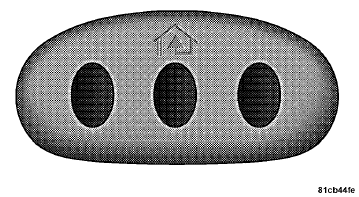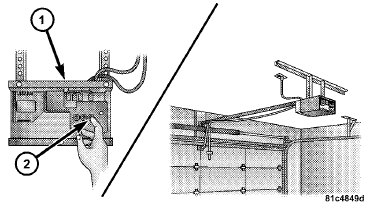Dodge Journey: GARAGE DOOR OPENER — IF EQUIPPED
HomeLink replaces up to three remote controls (handheld transmitters) that operate devices such as garage door openers, motorized gates, lighting or home security systems. The HomeLink unit operates off your vehicle’s battery.
The HomeLink buttons that are located in the headliner or sun visor designate the three different HomeLink channels.

HomeLink Buttons
NOTE: HomeLink is disabled when the Vehicle Security Alarm is active.
WARNING:
• Your motorized door or gate will open and close
while you are training the Universal Transceiver.
Do not train the transceiver if people, pets or other objects are in the path of the door or gate. Only use this transceiver with a garage door opener that has a “stop and reverse” feature as required by Federal safety standards. This includes most garage door opener models manufactured after 1982. Do not use a garage door opener without these safety features. Call toll-free 1–800–355–3515 or, on the Internet at www.HomeLink.com for safety information or assistance.
• Vehicle exhaust contains carbon monoxide, a dangerous gas. Do not run your vehicle in the garage while training the transceiver. Exhaust gas can cause serious injury or death.
Programming HomeLink
Before You Begin
If you have not trained any of the HomeLink buttons, erase all channels before you begin training.
To do this, press and hold the two outside buttons for 20 seconds until the red indicator flashes.
It is recommended that a new battery be placed in the handheld transmitter of the device that is being copied to HomeLink for more efficient training and accurate transmission of the radio-frequency signal.
Your vehicle should be parked outside of the garage when programming.
1. Turn the ignition switch to the ON/RUN position.
2. Hold the battery side of the handheld transmitter away from the HomeLink button you wish to program.
Place the handheld transmitter 1–3 in (3-8 cm) away from the HomeLink button you wish to program while keeping the indicator light in view.
3. Simultaneously press and hold both the chosen HomeLink button and the handheld transmitter button until the HomeLink indicator changes from a slow to a rapidly blinking light, then release both the HomeLink and handheld transmitter buttons.
Watch for the HomeLink indicator to change flash rates.
When it changes, it is programmed. It may take up to 30 seconds or longer in rare cases. The garage door may open and close while you train.
NOTE:
• Some gate operators and garage door openers may
require you to replace Step 3 with procedures noted in
the “Gate Operator/Canadian Programming” section.
• After training a HomeLink channel, if the garage door does not operate with HomeLink and the garage door opener was manufactured after 1995, the garage door opener may have a rolling code. If so, proceed to the heading “Programming A Rolling Code System.”
4. Press and hold the just-trained HomeLink button and observe the indicator light.
If the indicator light stays on constantly, programming is complete and the garage door (or device) should activate when the HomeLink button is pressed.
If the indicator light blinks rapidly for two seconds, and then turns to a constant light, continue with programming for a Rolling Code.
5. PROGRAMMING A ROLLING CODE SYSTEM
At the garage door opener motor (in the garage), locate the “Learn” or “Training” button.
This can usually be found where the hanging antenna wire is attached to the garage door opener motor (it is NOT the button normally used to open and close the door).

1 — Garage Door Opener.
2 — Training Button.
6. Firmly press and release the LEARN or TRAINING button. The name and color of the button may vary by manufacturer.
NOTE: You have 30 seconds in which to initiate the next step after the LEARN button has been pressed.
7. Return to the vehicle and press the programmed HomeLink button twice (holding the button for two seconds each time). If the device is plugged in and activates, programming is complete.
If the device does not activate, press the button a third time (for two seconds) to complete the training.
If you have any problems, or require assistance, please call toll-free 1–800–355–3515 or, on the Internet at www.HomeLink.com for information or assistance.
To program the remaining two HomeLink buttons, repeat each step for each remaining button. DO NOT erase the channels.
Gate Operator/Canadian Programming
Canadian radio-frequency laws require transmitter signals to “time-out” (or quit) after several seconds of transmission – which may not be long enough for HomeLink to pick up the signal during programming.
Similar to this Canadian law, some U.S. gate operators are designed to “time-out” in the same manner.
It may be helpful to unplug the device during the cycling process to prevent possible overheating of the garage door or gate motor.
If you are having difficulties programming a garage door opener or a gate operator, replace “Programming HomeLink ” Step 3 with the following: 3. Continue to press and hold the HomeLink button, while you press and release (“cycle”), your handheld transmitter every two seconds until HomeLink has successfully accepted the frequency signal. The indicator light will flash slowly and then rapidly when fully trained.
If you unplugged the device for training, plug it back in at this time.
Then proceed with Step 4 under “Programming HomeLink ” earlier in this section.
Using HomeLink
To operate, press and release the programmed HomeLink button. Activation will now occur for the trained device (i.e., garage door opener, gate operator, Security system, entry door lock, home/office lighting, etc.,). The handheld transmitter of the device may also be used at any time.
Reprogramming A Single HomeLink Button
To reprogram a channel that has been previously trained,
follow these steps:
1. Turn the ignition switch to the ON/RUN position.
2. Press and hold the desired HomeLink button until the indicator light begins to flash after 20 seconds. Do not release the button.
3. Without releasing the button, proceed with Programming HomeLink Step 2 and follow all remaining steps.
Security
It is advised to erase all channels before you sell or turn in your vehicle.
To do this, press and hold the two outside buttons for 20 seconds until the red indicator flashes. Note that all channels will be erased. Individual channels cannot be erased.
The HomeLink Universal Transceiver is disabled when the Vehicle Security Alarm is active.
Troubleshooting Tips
If you are having trouble programming HomeLink , here are some of the most common solutions: • Replace the battery in the original transmitter.
• Press the LEARN button on the Garage Door Opener to complete the training for a Rolling Code.
• Did you unplug the device for training, and remember to plug it back in?
If you have any problems, or require assistance, please call toll-free 1–800–355–3515 or, on the Internet at www.HomeLink.com for information or assistance.
General Information
This device complies with FCC rules Part 15 and Industry
Canada RSS-210. Operation is subject to the following
two conditions:
1. This device may not cause harmful interference.
2. This device must accept any interference that may be received including interference that may cause undesired operation.
NOTE: The transmitter has been tested and it complies with FCC and IC rules. Changes or modifications not expressly approved by the party responsible for compliance could void the user’s authority to operate the device.
The term IC before the certification/registration number only signifies that Industry Canada technical specifications were met.
 OVERHEAD CONSOLE
OVERHEAD CONSOLE
The overhead console contains courtesy/reading lights,
storage for sunglasses, an interior observation mirror and
an optional power sunroof switch.
Overhead Console
Courtesy/Reading Lights
Refe ...
 POWER SUNROOF — IF EQUIPPED
POWER SUNROOF — IF EQUIPPED
The power sunroof switch is located between the sun
visors on the overhead console.
Power sunroof Switch
WARNING:
• Never leave children in a vehicle with the key in
the ignition switch. Occu ...
See also:
Speaker
OPERATION
Two wires connected to each speaker, one feed circuit (+) and one return
circuit (-), allow the audio output signal electrical current to flow through
the voice coil. The wiring informa ...
Description, Operation
DESCRIPTION
This vehicle is equipped with a Wireless Ignition Node (WIN) (1). The WIN and
the FOB with Integrated Key
(FOBIK) are the primary components of the keyless ignition system. The only
...
Task manager
Description
The PCM is responsible for efficiently coordinating the operation of all the
emissions-related components. The
PCM is also responsible for determining if the diagnostic systems are ope ...
